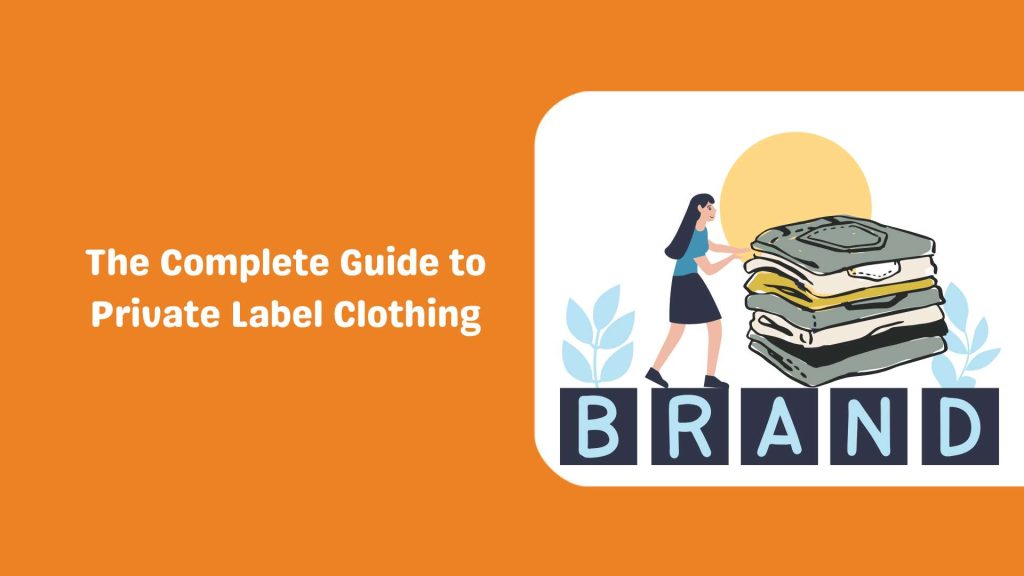In this article, we will explore the ever-evolving world of private label clothing. This topic is significant for businesses looking to enhance their brand identity and engage with consumers more effectively. The main objectives are to dissect the intricacies of private label clothing, delve into its advantages, startup strategies, market positioning, and future trends, while integrating actionable insights and data that empower businesses to thrive in the industry.
What is Private Label Clothing?

Private label clothing refers to apparel produced by one company but marketed under another company’s brand name. Retailers often choose this route for various reasons, primarily for brand control and the ability to customize their offerings. But here’s the kicker: private label clothing allows businesses to create unique designs that resonate with their target audiences while outsourcing the production process. This distinction between private label and white label clothing is crucial since white label products are typically generic items that multiple brands can sell without customization.
The rise of e-commerce has significantly impacted private label clothing. Businesses now have unprecedented access to consumers and can utilize online platforms to reach larger audiences. By leveraging custom clothing manufacturing, brands can introduce products that cater specifically to market demands, thus maximizing profitability.
What’s the real story? Brands can efficiently manage their inventory, ensuring that they only produce items that sell well, which decreases waste. Moreover, private labeling provides retailers the opportunity to test new product lines without the significant investment typically associated with traditional manufacturing. By collaborating with manufacturing partners, let’s not forget the vital role these relationships play in maintaining quality control and brand consistency. The integration of private labeling into a business model can be a game-changer for many entrepreneurs looking to carve out their niche in a crowded market.
| Features | Private Label Clothing | White Label Clothing |
|---|---|---|
| Customization | High customization level | Limited customization |
| Brand Control | Complete control over branding and marketing | Shared branding, often generic supply |
| Profit Margins | Typically higher given exclusive branding | Variable, often lower due to competition |
| Market Positioning | Unique market position with tailored offerings | More competitive pricing but less differentiation |
What Are the Advantages of Private Label Clothing?
The advantages of private label clothing are compelling. First and foremost, businesses enjoy lower production costs, thanks to outsourcing manufacturing to specialized suppliers. By partnering with custom clothing manufacturers, retailers can streamline their operations, reducing overhead while maintaining high-quality standards. This approach allows brands to focus on core competencies, such as marketing and customer service, rather than getting bogged down in production logistics.
Moreover, private label clothing offers unparalleled flexibility. Brands can quickly adapt to changing consumer preferences by introducing new styles, colors, or sizes without overhauling their entire inventory. What’s even more interesting is the ability to test product lines with minimal financial risk. For instance, a startup fashion brand can launch a limited collection using low MOQ (minimum order quantity) clothing suppliers, enabling them to gauge market response before scaling production.
Another significant advantage is the opportunity for brand differentiation. With a unique product lineup, businesses can carve out their niche, engaging consumers who value exclusivity. Private label clothing also cultivates customer loyalty, as shoppers often prefer to buy from recognized brands that align with their values or styles.
It’s essential to recognize the broader market context; as more consumers seek authenticity in their purchases, private label clothing serves as an ideal vehicle for brands aiming to build a relatable image. The implications are profound: brands can leverage their private label products to align with consumer trends, fostering a deeper emotional connection with their audience.
| Advantages | Explanation |
|---|---|
| Cost Efficiency | Lower production costs through outsourcing |
| Flexibility | Easily adapt to trends and consumer preferences |
| Differentiation | Unique products that enhance brand image |
| Customer Loyalty | Exclusive offerings encourage repeat business |
How to Start a Private Label Clothing Brand

Starting a private label clothing brand involves several critical steps. First, entrepreneurs need to identify their target market. Knowing who you’re selling to is vital for developing products that resonate. Ready for the good part? This phase often includes market research to pinpoint consumer preferences and gaps in the current market.
Next, sourcing the right private label clothing manufacturers is crucial. The ideal partner should provide quality assurance, reliable production timelines, and reasonable pricing structures. Utilizing platforms that connect businesses with low MOQ clothing suppliers can help new brands manage risk while testing product viability.
Developing a brand identity is another pivotal step. This includes choosing a brand name, logo, and overall aesthetic that conveys the desired message to the target audience. Additionally, creating high-quality product samples is essential for presenting a professional image to potential buyers and ensuring that the final output meets quality standards.
Establishing an online presence is also vital for new brands. Engaging in digital marketing strategies, such as utilizing social media and SEO tactics, can drive traffic to your site. Influencer partnerships can also be a great way to build credibility and reach potential customers.
What’s more, managing customer feedback during the early stages can provide valuable insights into improving product offerings, ensuring that you deliver what consumers truly want. By integrating these practices, entrepreneurs can position their private label clothing brand for future success while navigating the challenges inherent in any new venture.
Runtoagent, a trusted private label supplier in China, helps startups access low-MOQ production with factory-direct pricing.
| Step | Description |
|---|---|
| Identify Target Market | Conduct market research to understand consumer needs |
| Source Manufacturers | Find reliable private label clothing manufacturers |
| Develop Brand Identity | Create a memorable brand name and aesthetics |
| Establish Online Presence | Utilize social media and SEO for visibility |
Choosing the Right Market Positioning
Market positioning is crucial for the success of private label clothing. The brand’s identity must resonate with its target audience while distinguishing itself in a competitive landscape. But here’s where it gets interesting: proper positioning can drastically improve sales and customer loyalty.
To achieve effective clothing brand positioning, businesses can begin by defining their unique selling proposition (USP). What differentiates your brand from competitors? Whether it’s sustainability, affordability, or luxury, clarity on this point helps guide marketing efforts.
Brands should also analyze consumer demographics thoroughly. This includes identifying age groups, lifestyle preferences, and purchasing behaviors that align with the product offerings. Utilizing data from market research can provide actionable insights for tailoring marketing messages and promotions to resonate with the target audience.
Additionally, aligning product lines with consumer values is essential. For instance, businesses focusing on eco-friendly practices can attract consumers that prioritize sustainability. Highlighting these aspects in branding efforts can enhance brand positioning and help establish trust with potential customers.
What’s the takeaway? A well-defined brand position not only aids in marketing efforts but also informs product development, ensuring alignment with consumer expectations. By continuously assessing market dynamics, businesses can maintain relevance and adjust strategies accordingly to meet changing demands effectively.
| Element | Consideration |
|---|---|
| Unique Selling Proposition | What makes your brand stand out? |
| Consumer Demographics | Understand the target audience’s characteristics |
| Brand Values | Align product offerings with consumer ethics |
| Market Dynamics | Regularly assess competition to stay relevant |
Collaboration and Supply Chain Management
Effective collaboration with suppliers is key to the success of a private label clothing brand. The intricacies of supply chain management can make or break a product launch. Understanding these dynamics helps brands to optimize operations and minimize delays. What’s the secret here? Building strong relationships with suppliers can lead to better communication, reduced lead times, and higher-quality products.
Start by establishing clear communication channels. Regular check-ins and updates can help ensure that production timelines are met, and any issues are promptly addressed. A reliable OEM/ODM (Original Equipment Manufacturer/Original Design Manufacturer) can provide valuable insights into material sourcing and production techniques, enabling brands to enhance quality and design.
For streamlined sourcing and fulfillment, Runtoagent offers end-to-end apparel solutions tailored to your brand.
Another critical aspect is logistics. Clever inventory management practices can help businesses maintain an optimal stock level, reducing carrying costs while ensuring that products are readily available when consumers make a purchase. Many brands are increasingly adopting dropshipping fulfillment services that allow them to fulfill orders directly from manufacturers, minimizing the need for excess inventory.
Also, it’s essential to evaluate the production process continuously. By analyzing what works and what doesn’t, businesses can make data-informed adjustments to their supply chain strategies. What’s even more concerning? Not addressing potential bottlenecks could result in delays and lost sales opportunities.
Ultimately, collaboration and supply chain management should be viewed as an ongoing process of improvement. By fostering strong partnerships and maintaining open lines of communication, brands can navigate challenges effectively while ensuring that they deliver exceptional products to their customers.
| Collaboration Aspect | Importance |
|---|---|
| Clear Communication | Prevents misunderstandings and promotes efficiency |
| Supplier Relationships | Can enhance product quality and reliability |
| Logistics Management | Reduces costs and ensures product availability |
| Continuous Evaluation | Enables proactive adjustments to supply chain |
Developing Effective Marketing Strategies
Marketing strategies for private label clothing should be tailored to the brand’s unique identity and target audience. In a world filled with options, differentiating your private label clothing brand is vital. Here’s what you need to consider: engaging storytelling will resonate with consumers and foster brand loyalty.
Utilizing social media platforms is an essential part of a modern marketing strategy. Brands can showcase their products through authentic imagery and engaging content, building a community around their values. From Instagram reels to Facebook ads, brands have an array of digital tools at their disposal to reach potential buyers.
Content marketing is another effective strategy. Providing valuable information, such as style guides, behind-the-scenes looks at the production process, or sustainability initiatives, can engage customers and convert them into loyal advocates. This kind of content creates an emotional connection, reinforcing brand values.
Influencer partnerships are also invaluable. By collaborating with influencers that align with the brand’s identity, companies can leverage their followers and gain credibility in niche markets. Studies show that influencers can drive significant engagement, leading to increased conversion rates.
Lastly, analyzing customer behaviors and preferences through targeted surveys or feedback sessions can refine marketing strategies further, ensuring that messaging remains relevant and impactful. What does this mean for businesses? By adopting a customer-centric approach and implementing varied marketing strategies, private label clothing brands can thrive in today’s competitive landscape.
| Marketing Strategy | Description |
|---|---|
| Social Media Engagement | Use visuals and campaigns to connect with audiences |
| Content Marketing | Provide valuable information that resonates |
| Influencer Collaborations | Leverage followers to enhance visibility |
| Customer Feedback Analysis | Iterate marketing strategies based on consumer input |
Unique Product Offerings

Creating unique product offerings is vital for private label clothing brands. With competition at an all-time high, what’s the game plan? Brands need to differentiate themselves through innovative designs and exclusive collections.
Start by researching current trends and consumer preferences. Understanding what consumers are searching for makes it easier to develop a product line that stands out. Collaborating with fashion designers or trend forecasters can lead to exciting, fresh ideas that align with market demand.
Another approach is launching a made-to-order fashion line. This model minimizes overproduction and allows consumers to customize specific features of their clothing, such as color and fit. The consumer engagement with this level of personalization fosters brand loyalty and a unique shopping experience.
Additionally, considering sustainable practices in the product development phase can appeal to environmentally conscious consumers. Brands that prioritize eco-friendly materials or ethical production often attract dedicated followings.
Finally, limited edition releases can create a sense of urgency and exclusivity. This strategy not only drives sales but also engages customers who want to feel part of a select group. What’s the takeaway? Focusing on unique offerings ensures that brands not only attract customers but also retain loyalty in a rapidly evolving marketplace.
| Strategy | Description |
|---|---|
| Research Trends | Identify current demands and consumer preferences |
| Made-to-Order Options | Offer customization to enhance engagement |
| Sustainable Practices | Align products with environmental values |
| Limited Edition Releases | Create urgency and exclusivity to drive sales |
Challenges Faced in Private Label Clothing
Navigating the private label clothing landscape comes with its share of challenges. Inevitably, as brands work to establish themselves, they face obstacles that can hinder growth. What are these challenges? Understanding them is crucial for developing effective strategies.
One significant challenge is maintaining quality control with outsourced manufacturing. Without proper oversight, brands risk receiving subpar products that can damage their reputation. It’s essential to establish clear quality standards and conduct regular audits to ensure compliance.
Additionally, market saturation is a concern. With more entrants into the private label space, standing out amidst the clutter can be daunting. Brands must continuously innovate and refine their product offerings to stay relevant, or risk fading into obscurity.
Another common pitfall is misreading market demands. Investing heavily in a collection that does not resonate with consumers can lead to significant financial losses. Data analysis and customer feedback must be prioritized to mitigate this risk.
Lastly, managing logistics effectively is another hurdle. Delays in production or shipment can lead to frustrated customers and eroded trust. Implementing robust logistical strategies, including clear communication with suppliers and contingency planning, can help navigate these challenges.
In conclusion, recognizing and addressing these challenges proactively enables private label clothing brands to build a sustainable business model. By focusing on quality, staying innovative, and maintaining strong customer relationships, brands can overcome obstacles and thrive in a competitive market.
| Challenge | Solution |
|---|---|
| Quality Control | Establish standards and conduct regular audits |
| Market Saturation | Focus on innovation and unique offerings |
| Misreading Market Demand | Prioritize data analysis and customer feedback |
| Logistics Management | Implement robust strategies and clear communication |
Future Trends in Private Label Clothing
The future of private label clothing promises exciting developments. As consumers demand authenticity and personalization, brands must adapt to meet these evolving expectations. What’s next on the horizon? Here are emerging trends that could shape the future of this industry.
Firstly, sustainability will play an increasingly crucial role. Brands that prioritize eco-friendly practices, from material sourcing to production methods, will likely attract the next generation of conscious consumers. Moreover, innovations in sustainable textiles present exciting new avenues for product development.
Tech integration is another trend that cannot be overlooked. Advancements in technology, such as AI-driven design tools or virtual fitting rooms, can enhance the shopping experience and allow brands to offer more personalized products.
Finally, the rise of online shopping continues to expand opportunities for private label brands. As e-commerce evolves, global e-commerce trends,so too does the importance of a seamless online experience. Brands that invest in enhancing their digital presence and user experience are likely to succeed in reaching consumers effectively.
In summary, embracing these trends will be essential for private label clothing brands aiming for longevity and relevance in the marketplace. Companies that remain adaptable and open to change will thrive, fusing innovation with the core values that consumers cherish.
| Trend | Implication |
|---|---|
| Sustainability | Attracts conscious consumers and enhances brand image |
| Tech Integration | Enhances the shopping experience and personalization |
| E-commerce Growth | Necessitates a focus on seamless digital interaction |
FAQ Section
Q1: What is private label clothing?
Private label clothing refers to garments manufactured by one company but marketed under another brand’s name, allowing brands to tailor offerings for their consumers.
Q2: How can I choose the best private label clothing manufacturer?
Selecting the ideal manufacturer involves market research, evaluating production capabilities, verifying quality standards, and establishing clear communication channels.
Q3: What distinguishes private label apparel from white label apparel?
Private label apparel allows brands to customize products extensively, whereas white label apparel typically offers generic options with less differentiation.
Q4: How can I effectively promote my private label clothing brand?
Social media engagement, content marketing, influencer collaborations, and customer feedback analysis are effective strategies for promoting your brand.
Q5: What are the most significant challenges of private label clothing?
Key challenges include maintaining quality control, navigating market saturation, misreading market demands, and managing logistics effectively.
In conclusion, private label clothing represents a unique opportunity for brands to express their identity while connecting with consumers. By understanding the intricacies and best practices of this model, businesses can thrive in a competitive landscape. As we move forward, staying abreast of trends and adapting strategies will be crucial for sustained growth.
Partnering with reliable firms like Runtoagent can give your brand the competitive edge it needs in private label fashion.







